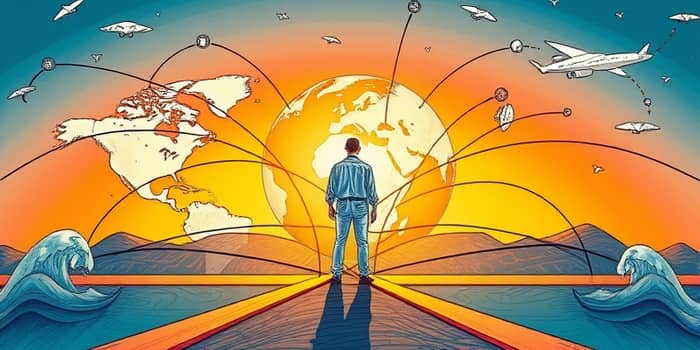
In the dynamic landscape of late 2025, decision-makers face a maze of interconnected challenges that test the boundaries of traditional leadership. Slowing global GDP growth, rising trade barriers, and geopolitical crosscurrents demand an evolved perspective. This article unpacks the critical trends shaping business, government, and civil society, providing a beacon for leaders intent on steering organizations toward sustainable success. Our exploration weaves data-driven insights with practical frameworks to empower you on every step of this journey.
The global economy is projected to decelerate to 2.3% growth in 2025, reflecting headwinds from escalating protectionism and policy uncertainty. Chief risk officers warn of an unsettled and volatile global environment where even minor shocks can cascade across geographies. Trade fragmentation is estimated to cost between $600 billion and $5.7 trillion annually, pressuring margins and complicating supply chains. Meanwhile, public and private debt service costs have surged, limiting fiscal room for stimulus and investment.
The real estate sector also illustrates these strains. China’s new home sales are forecast to decline by 12%, while commercial property in the US and Europe grapples with valuation declines due to hybrid work and higher financing costs. Debt remains a critical constraint:
Understanding these dynamics is essential for executives seeking to identify pockets of opportunity amidst volatility. Embracing trade fragmentation and rising tariffs as variables to model, rather than anomalies to ignore, can reveal strategic pathways for resilient expansion.
Technology continues to rewrite the rules of competition. In 2025, 86% of employers expect AI and advanced analytics to reshape their sectors. An estimated 97 million new jobs are emerging, yet 85–92 million roles face displacement due to automation. This duality underscores the imperative for rapid workforce reskilling and upskilling programs to bridge skill gaps and maintain market relevance.
Generative AI, in particular, is driving innovation in content creation, design, and decision support. Organizations that integrate these capabilities can accelerate product development cycles by up to 50% and enhance customer engagement through personalized experiences. However, ethical considerations around data privacy and algorithmic bias demand robust governance frameworks and transparent communication to build trust.
Equity remains a critical challenge. Women and youth must be included in STEM education and vocational training to prevent widening digital divides. Leaders who champion mentorship, apprenticeships, and public-private partnerships can foster inclusive growth and unlock untapped talent pools.
The geopolitical terrain is shifting beneath our feet. US policy choices—characterized by record-high average tariffs of 18.2%—have introduced a new and uncertain policy mix for global commerce. China, in response, is forging stronger ties with the Global South, where over 60% of the world’s population resides. Exports from China to Mexico and Canada have surged 25%, while shipments to Europe grew 6% year-over-year.
These realignments have given rise to regional economic blocs, bilateral innovation hubs, and sovereign wealth funds diversifying into green technology and strategic minerals. Fragmented alliances mean that multinationals must cultivate diplomatic acumen, local insights, and agile operating models that can adjust to varying regulatory regimes and security dynamics.
Climate change is no longer a remote concern but a core risk driver. In 2024, global temperatures rose to 1.55°C above pre-industrial levels, prompting $320 billion in disaster-related losses, of which only $145 billion were insured. Leaders must prioritize sustainable infrastructure investment priorities to fortify assets, reduce emissions, and secure long-term resilience.
Governments and corporations are channeling trillions of dollars into renewable energy, electric transport, and circular economy initiatives. Yet progress is uneven. Regions with limited capital face critical gaps in grid modernization and adaptive capacity. Public-private collaboration, blended finance, and innovative insurance models are essential to accelerate impact at scale.
Additionally, rising lifespans necessitate a reimagining of the labor force. The longevity economy requires pension and healthcare systems to adapt, while companies redesign roles to leverage the experience of older workers, ensuring intergenerational knowledge transfer and sustained productivity.
In response to these converging trends, leaders must embrace agility in strategic decision making to outmaneuver uncertainty. Long-term plans are giving way to rolling horizons, where hypotheses are tested, refined, or abandoned based on real-time data and scenario outcomes. Supply chain resilience strategies—such as regional hubs, dual sourcing, and digital twins—are now non-negotiable.
Strategic partnerships amplify impact. With 43% of executives increasing collaboration budgets, co-innovation with universities, start-ups, and public agencies has become a potent catalyst for breakthrough technologies and market access.
Turning insight into action requires structured frameworks. Organizations should leverage multilateral collaboration and scenario planning to anticipate geopolitical shifts and counter misinformation. Building a continuous learning and innovation culture ensures that teams adapt as technology and policy landscapes evolve.
Case studies abound: a leading electronics firm reduced supply disruption risk by 45% after diversifying its component network; a global insurer launched micro-policies for climate events, unlocking $200 million in previously untapped premiums. These examples illustrate how unparalleled strategic leadership demands a blend of foresight, collaboration, and relentless execution.
As you apply these principles, remember that complexity can be a crucible for innovation and growth. By integrating data-driven analysis with human-centric leadership—prioritizing trust, inclusivity, and purpose—you position your organization to thrive. The global economy of 2025 may be intricate, but it offers boundless opportunity for those ready to lead with vision and resilience.
References





